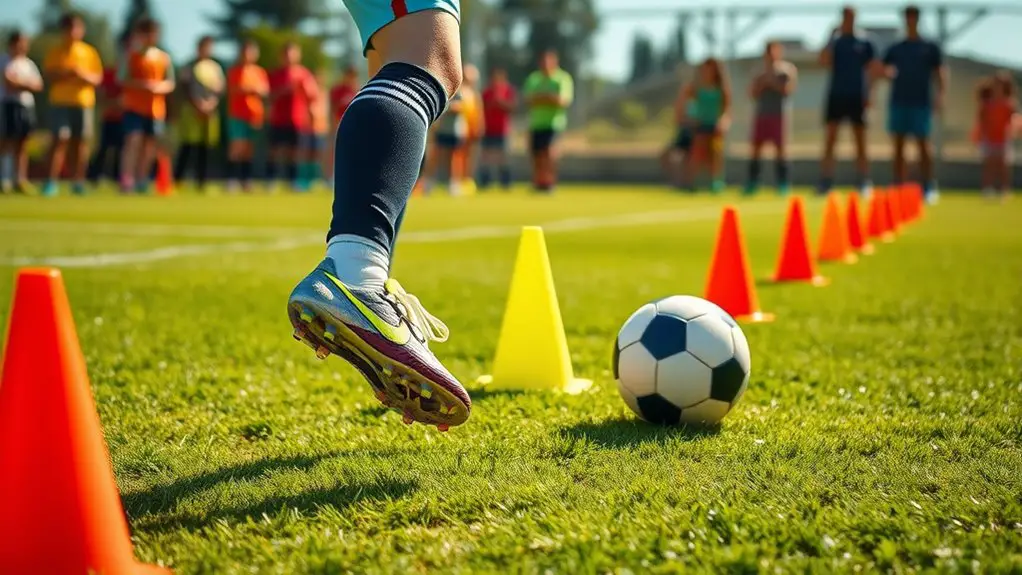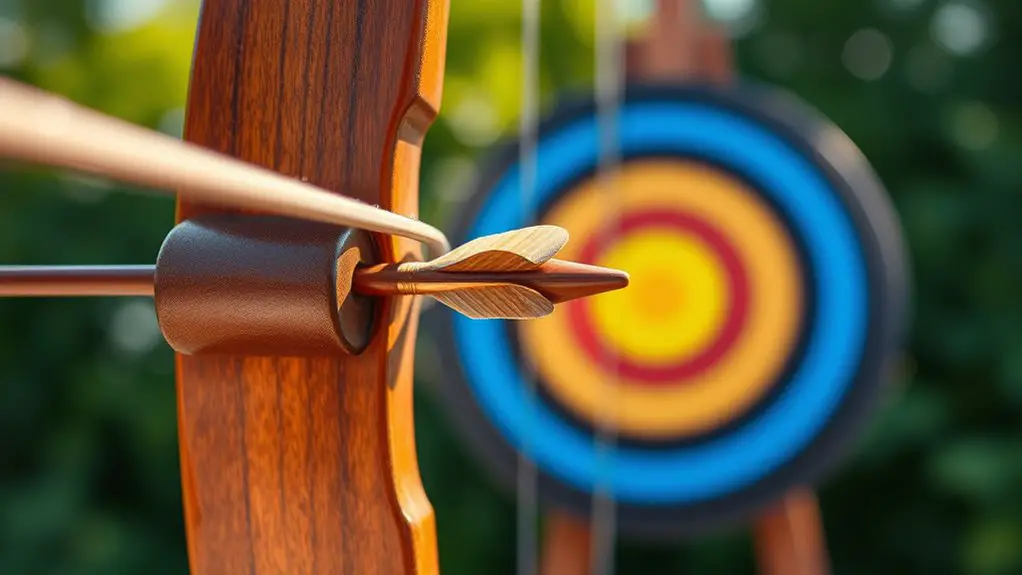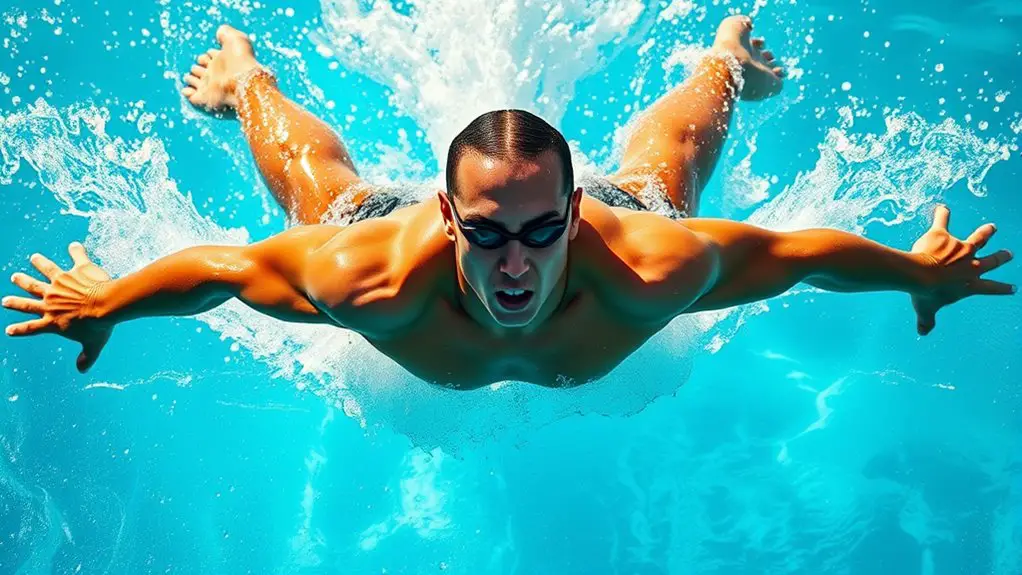To improve your soccer footwork, focus on agility drills like ladder drills for quick feet and cone drills for directional changes. Incorporate plyometric box jumps to boost explosiveness, while shuttle runs enhance your speed and endurance. Don't forget agility hurdles for coordination and side shuffles for lateral movement. T-drills refine your acceleration and deceleration, while ball mastery and mirror drills sharpen footwork precision and reactive agility. There's so much more you can explore to elevate your game.
Ladder Drills for Quick Feet
Ladder drills are some of the most effective exercises for improving your footwork in soccer. These drills challenge your agility and speed, giving you the freedom to move with confidence on the field. By incorporating various ladder variations, you can target different aspects of your foot placement and movement patterns.
Start with basic in-and-out steps to get comfortable with the ladder's rhythm. Once you've mastered that, try lateral shuffles or crossover steps to enhance your quickness. Remember, precise foot placement is key; it helps you maintain balance and control, allowing for explosive movements when it counts.
As you practice, focus on keeping your knees high and your steps light. This will not only improve your footwork but also build the muscle memory needed for game situations. Incorporating agility ladder drills into your regular training routine will help you embrace the challenge, and you'll find yourself moving with newfound agility and flair on the pitch!
Cone Drills for Directional Change
While ladder drills enhance your foot speed, cone drills are perfect for improving your ability to change direction quickly and effectively. By adjusting cone placement, you can create various patterns that challenge your directional agility. Start with two cones set about five yards apart. Sprint to one cone, plant your foot, and quickly pivot to face the other cone. Repeat this back and forth, focusing on maintaining control and speed.
You can increase the challenge by adding more cones in different formations, like zigzags or circles, which will keep your body guessing and enhance your responsiveness on the field. Remember, the key to effective cone drills is to maintain proper form while pushing your limits. These drills not only improve your agility but also help you feel more confident when making those vital game-time decisions. Incorporating footwork drills into your routine will further enhance your skills. So, grab some cones and let your freedom of movement shine!
Plyometric Box Jumps for Explosiveness
Plyometric box jumps are a great way to boost your explosiveness on the field. You'll want to focus on proper jumping technique to maximize benefits and prevent injury. Plus, there are various progression variations you can try to keep your workouts challenging and effective. Incorporating explosive movements into your training routine can significantly enhance your overall athletic performance.
Benefits of Box Jumps
Box jumps are a powerful tool for enhancing explosiveness in soccer players, as they engage multiple muscle groups and improve your overall power output. Incorporating box jumps into your training routine offers several benefits:
- Injury Prevention: By strengthening your legs and core, you'll reduce the risk of injuries on the field.
- Muscle Activation: These jumps activate fast-twitch muscle fibers, vital for quick sprints and directional changes during a match.
- Improved Agility: The explosive nature of the jumps translates well into better footwork and agility, essential for maneuvering around defenders.
Proper Jumping Technique
Mastering proper jumping technique is essential for maximizing the benefits of box jumps and enhancing your explosiveness on the soccer field. Start with your feet shoulder-width apart, ensuring a solid base. As you prepare to jump, engage your core and bend your knees while keeping your back straight. Focus on the jumping mechanics: use your arms to generate momentum and drive them upward as you leap. Aim to land softly, absorbing the impact through your legs to maintain balance. This technique not only boosts your explosive power but also minimizes the risk of injury. By honing your jumping mechanics, you'll reveal a new level of agility and performance, giving you that freedom to dominate the field.
Variations for Progression
While box jumps are a fantastic way to build explosiveness, incorporating variations can take your training to the next level. These progressive challenges not only enhance your power but also promote skill refinement. Here are a few variations to mix into your routine:
- Single-leg box jumps: Increase balance and strength on each leg.
- Lateral box jumps: Enhance agility and lateral movement for better game performance.
- Drop jumps: Focus on reactive strength by jumping immediately after landing from a height.
Shuttle Runs for Speed and Endurance
When it comes to boosting your speed and endurance, shuttle runs are a game-changer. Not only do they enhance your overall fitness, but mastering the right technique is key to maximizing their benefits. Incorporating lateral movement drills into your shuttle run routine can further improve your agility on the field.
Benefits of Shuttle Runs
Although shuttle runs may seem simple, they offer significant benefits for soccer players by enhancing both speed and endurance. By incorporating shuttle runs into your training, you can experience:
- Improved sprinting technique: You'll develop better control and efficiency during sprints, essential for quick direction changes on the field.
- Increased aerobic capacity: Shuttle runs push your limits, helping build stamina for those intense game moments.
- Enhanced agility: The back-and-forth nature of shuttle runs sharpens your reflexes and footwork, making you more elusive to opponents.
Embracing these shuttle run benefits not only boosts your performance but also gives you the freedom to play with confidence. So, lace up your cleats and get running—you'll notice the difference in no time!
Technique for Success
To maximize the benefits of shuttle runs for speed and endurance, focusing on proper technique is crucial. Good foot placement guarantees you maintain balance and agility, allowing for quick changes in direction. Here's a quick guide to help you refine your approach:
| Technique Aspect | Tips |
|---|---|
| Foot Placement | Land on the balls of your feet for quicker reactions. |
| Body Position | Keep your knees slightly bent and your core engaged. |
| Arm Movement | Swing your arms to aid momentum and balance. |
| Breathing | Breathe rhythmically to maintain endurance. |
| Recovery | Allow time for rest to prevent fatigue and injury. |
Embrace these tips, and you'll notice improvements in your speed and overall performance!
Agility Hurdles for Coordination
Agility hurdles can considerably enhance your coordination on the soccer field, helping you navigate tight spaces and evade defenders with ease. By incorporating agility hurdle techniques into your training, you'll develop quick footwork and improve your overall performance. Here are some coordination improvement strategies you can try:
- Single-leg hops: Jump over the hurdles on one leg to challenge your balance and stability.
- Lateral jumps: Move side-to-side over the hurdles to increase agility and responsiveness.
- Forward sprints: Sprint through the hurdles, focusing on quick feet and maintaining speed.
These drills aren't just about speed; they're designed to build the precise coordination you need during a match. Additionally, improving overall sports performance through agility drills can significantly boost your effectiveness on the field. With consistent practice, you'll feel more in control, making it easier to execute those vital moves when it counts. So, get out there and embrace the freedom that agility hurdles can bring to your game!
Side Shuffles for Lateral Movement
Mastering side shuffles can greatly enhance your lateral movement on the soccer field. This essential skill not only improves your agility but also helps you evade opponents with ease. Here are some effective side shuffle techniques to contemplate:
| Technique | Description | Lateral Movement Benefits |
|---|---|---|
| Basic Side Shuffle | Stay low, push off with both feet | Increases speed and agility |
| Crossover Shuffle | Cross one foot over the other | Enhances balance and coordination |
| Plyometric Shuffle | Add jumps between shuffles | Builds explosive power |
| Resistance Shuffle | Use bands for added resistance | Strengthens hip and leg muscles |
Incorporating these drills into your training routine can release your potential, allowing you to navigate the field with newfound freedom. Additionally, developing quick direction changes through side shuffles can significantly impact your overall performance on the field. So, get out there and embrace the joy of movement!
T-drills for Acceleration and Deceleration
After honing your lateral movement with side shuffles, it's time to focus on T-drills, which are fantastic for improving acceleration and deceleration. This drill helps you master essential acceleration techniques and refine your deceleration mechanics, giving you an edge on the field. Incorporating agility drills into your training routine will enhance your overall footwork and performance during matches.
Elevate your game with T-drills to enhance acceleration and deceleration skills on the field.
Here's how to execute the T-drill:
- Start at the base of the "T" and sprint to the top.
- Shuffle to either side before sprinting back to the base.
- Repeat the process to build speed and control.
Ball Mastery Drills for Footwork Precision
While improving your footwork is essential for success on the soccer field, mastering ball control is equally important. Ball mastery allows you to express your style and creativity while executing plays. Start with simple footwork drills like toe-touches and inside-out touches. These exercises help you develop a feel for the ball, making it easier to maneuver during games.
As you gain confidence, incorporate more dynamic drills, like juggling or dribbling through cones. These activities not only enhance your ball control but also refine your footwork, giving you that extra edge. Try varying your pace and direction to simulate real-game scenarios, allowing you to adapt on the fly.
Mirror Drills for Reactive Agility
Improving your ball control sets a strong foundation for developing reactive agility, which is essential in soccer. Mirror drills are fantastic for this purpose, as they challenge your responsiveness and help you adapt quickly to changing situations on the field. By using mirror variations, you can enhance your agility and footwork while having fun.
Here are three effective mirror drills to try:
- Partner Mirrors: Work with a partner who mimics your movements, forcing you to react and adjust.
- Cone Mirrors: Set up cones and have someone direct you to move between them, boosting your decision-making skills.
- Shadowing: Have a teammate lead while you follow, ensuring you stay on your toes and remain aware of their movements.
Incorporating these exercises into your training will elevate your gameplay, making you more dynamic and unpredictable on the pitch. Additionally, practicing mental alertness and awareness during these drills will further enhance your reaction times and overall performance.
Frequently Asked Questions
How Often Should I Practice Agility Drills per Week?
When it comes to honing your skills, finding the right rhythm is key. You might consider practicing agility drills about three to four times a week. This frequency recommendation balances training intensity with recovery, letting your body adapt and grow stronger. Enjoy the freedom to explore different drills while ensuring you're not overdoing it. Remember, it's about quality over quantity, so focus on making each session count for your overall development.
What Age Is Appropriate to Start Agility Training?
You can start agility training for kids as young as 6 or 7, but it really depends on their development stages. Youth training should focus on fun and basic movement skills rather than intense drills. It's important to create a positive experience that encourages them to enjoy physical activity. As they grow and develop, you can gradually introduce more complex drills, ensuring they stay engaged and excited about their progress.
Can Agility Drills Prevent Injuries in Soccer Players?
Think of agility drills like a safety net for a tightrope walker; they're essential for maintaining balance and preventing falls. In soccer, these drills can indeed aid in injury prevention by enhancing your balance, coordination, and overall body awareness. When you incorporate effective training, you're not just improving performance but also reducing the risk of injuries. So, embrace agility training, and you'll enjoy the freedom to play without the constant worry of getting hurt.
How Can I Track My Progress in Agility Training?
To track your progress in agility training, start by setting clear progress metrics. You could measure your speed, reaction time, and the number of successful drills completed. Keeping a training log helps too; jot down your performance after each session to see improvements over time. This way, you'll not only stay motivated but also have the freedom to adjust your training based on what works best for you. Celebrate those milestones!
Are Agility Drills Beneficial for Non-Soccer Athletes?
Imagine yourself darting across a field, quick and nimble, leaving your competition in the dust. Agility drills aren't just for soccer players; they're a game changer for any athlete. You'll experience agility benefits that enhance your overall athletic performance, improving speed, coordination, and reaction time. Whether you're into basketball, tennis, or just want to feel free on the field, incorporating these drills can elevate your game and release your inner potential.




